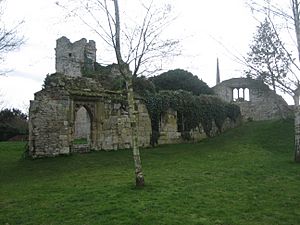Honour of Wallingford facts for kids

The Honour of Wallingford was like a very large estate or group of lands in medieval England. It was centered around Wallingford Castle in what is now Oxfordshire. This important area existed for a long time, from 1066 until 1540. It was controlled by powerful lords or the King himself.
Contents
How the Honour Began and Grew
The Honour of Wallingford started after the Norman Conquest of England in 1066. At first, it included lands like Wallingford and Harpsden. Over time, it grew to include many more areas.
Important People and Lands
One early owner was Miles Crispin. After he died in 1107, his wife Maud supported Empress Matilda in a big fight for the throne called the Anarchy. When King Stephen won, Maud's lands were given to Henry, Duke of Normandy. This added places like Aston Rowant to the Honour. Newton Purcell was also part of this Honour.
Wallingford and Magna Carta
The Honour of Wallingford is even mentioned in the famous Magna Carta of 1215. At that time, it was controlled by King John. The Magna Carta talked about how much money lords had to pay to the King for lands they held from such important estates. Until the 1200s, Chesterton, Oxfordshire was part of the Honour. Later, in 1360, Pyrton manor also joined.
Changes Over Time
In the 1200s, another important land group, the Honour of St. Valery, became connected to the Honour of Wallingford. This happened because the same person, the Earl of Cornwall, owned both.
Joining the Crown
When Edmund, 2nd Earl of Cornwall died in 1300 without children, the Honour of St. Valery went back to the King. By 1414, it was fully joined with the Honour of Wallingford. Finally, in 1540, the Honour of Wallingford was separated from the Duchy of Cornwall. It then became part of a new large estate called the Honour of Ewelme.
Famous Owners of the Honour
Many important people in English history held the Honour of Wallingford.
Royal Connections
- Piers Gaveston, 1st Earl of Cornwall received the Honour from King Edward II in 1307.
- Thomas Chaucer, a well-known figure and father of the famous poet Geoffrey Chaucer, was given the Honour by King Henry IV in 1399.
- William de la Pole, 1st Duke of Suffolk, became the person in charge of Wallingford Castle in 1434. When he died in 1450, the Honour was among his properties.
- His wife, Alice de la Pole, who was Thomas Chaucer's daughter, then held the Honour.
- Their son, John de la Pole, 2nd Duke of Suffolk, also later owned this important estate.

